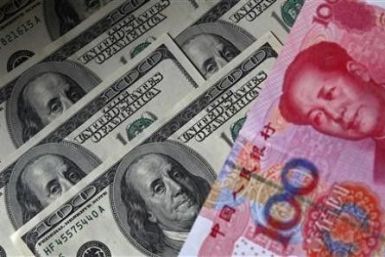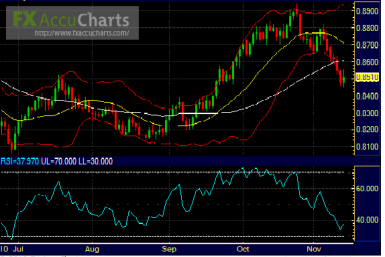After falling as low as 0.9779 from its previous close of 0.9827, AUD/USD is now targetting 0.9723 (S1) before hitting a relatively stronger support line at 0.9707 (S2).
Next target up for USD/CAD may be 1.0109 (R1) as suggested by the 38.2 percent Fibonacci retracement from 1.0285 to 1.0001, before a relatively stronger resistance near 1.0120 (R2).
Fundamentals for the commodity currency now back AUD/USD targeting 1.0006, as the 61.8 percent fibonacci from 1.0181 to 0.9723 projects.
GBP/USD has broken above the 1.5786 weak resistance (100-day SMA) and is heading towards the key 1.5838 medium-term resistance, as predicted by IBT FX on Monday. The level is also suggested by the upper Bollinger band on 4-hour chart.
The struggle of EUR/USD to free from the downward channel formed early November intensified after Friday's weak US jobs data, but the pair is finding it really difficult to break above the key long-term support-turned resistance of 1.3422.
If the pair consolidates above 1.56 levels, it might help confirm an intermediate short-term upward trend, and in that case, next important target for GBP/USD will be 1.5838 (R2), a medium term support-turned resistance for the pair.
Momentum indicators MACD and RSI on 4-hour chart suggest the pair is in oversold zone and up for a rebound. The first stop up (R1) for USD/JPY could be 83.40 as indicated by 100-day SMA and 23.6 percent Fibonacci and further higher, the pair has resistance near 83.7 (R2), as shown by the 50-day SMA.
USD/CAD is technically poised for a bounce back from current levels just above parity, but given the uncertainty about key data due later in the day, one should also be prepared for a move on the other side, which could easily take the pair to 0.9976 (S1) support.
Market is widely prepared for better readigs for both the EU indicators due Friday, and as of now, 1.3283 works out to be the nearest target upside on the 4-hour chart.
NZD/USD has broken below its key support level on Tuesday as dollar's across-the-board strength weighed on the kiwi currency, and at a near 2 month low, the pair is now testing its 100-day SMA on the daily chart. Momentum indicators clearly suggest the pair is in the oversold zone but a strong technical reversal also need the support of good news from the Euro-zone, traders said.
USD/CAD is currently holding near its 200-day moving average but the formation of an ascending triangle from start of this month has made the situation ripe for a jump on Tuesday, especially ahead of key data from the US and Canada.
USD/JPY tends to fall further as the session grows to Europe and given the market mood to stay prepared for more bad news from Portugal or Spain, likely in the coming days, the pair may only have a brief stop near 83.75 (S1), the 61.8 percent Fibonacci from late September levels. It could hold that level for the day.
South Korea's won that dropped to an 11-week low against the greenback following Tuesday's North Korean attack sharply rebounded on Wednesday, registering a 3.3 percent rally from the day's opening level.
The US dollar slipped in Asian trade on Wednesday, moving off multi-week highs against euro, pound, Aussie and New Zealand dollar, after rising sharply in the previous session which saw an unexpected Korean crisis providing the greenback with safe-haven interests.
The dust of G-20 has settled. World leaders sat around a large table set this time in South Korea, searched for that magic wand in their suit pockets, and then looked at each other's face with disappointment. They didn't get one to 'calm down' the emerging fears of a 'world war' on trade and currencies. They did not 'direct' China and/or US as some hoped.
Euro rose across the board and pulled off 1-1/2-month lows against the US dollar and British pound on Friday on news EU leaders reassured the holders of outstanding bonds that they would not be forced to take losses. The day's gains, however, did not prevent the single currency from heading for weekly losses versus the majors as investors are still worried that Ireland may default on its bonds.


























